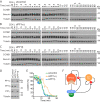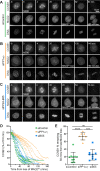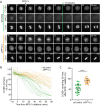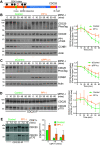PP1 promotes cyclin B destruction and the metaphase-anaphase transition by dephosphorylating CDC20
- PMID: 32755477
- PMCID: PMC7851957
- DOI: 10.1091/mbc.E20-04-0252
PP1 promotes cyclin B destruction and the metaphase-anaphase transition by dephosphorylating CDC20
Erratum in
-
Correction.Mol Biol Cell. 2021 Apr 1;32(7):634. doi: 10.1091/mbc.E20-04-0252-corr. Mol Biol Cell. 2021. PMID: 33793323 Free PMC article. No abstract available.
Abstract
Ubiquitin-dependent proteolysis of cyclin B and securin initiates sister chromatid segregation and anaphase. The anaphase-promoting complex/cyclosome and its coactivator CDC20 (APC/CCDC20) form the main ubiquitin E3 ligase for these two proteins. APC/CCDC20 is regulated by CDK1-cyclin B and counteracting PP1 and PP2A family phosphatases through modulation of both activating and inhibitory phosphorylation. Here, we report that PP1 promotes cyclin B destruction at the onset of anaphase by removing specific inhibitory phosphorylation in the N-terminus of CDC20. Depletion or chemical inhibition of PP1 stabilizes cyclin B and results in a pronounced delay at the metaphase-to-anaphase transition after chromosome alignment. This requirement for PP1 is lost in cells expressing CDK1 phosphorylation-defective CDC206A mutants. These CDC206A cells show a normal spindle checkpoint response and rapidly destroy cyclin B once all chromosomes have aligned and enter into anaphase in the absence of PP1 activity. PP1 therefore facilitates the metaphase-to-anaphase transition by promoting APC/CCDC20-dependent destruction of cyclin B in human cells.
Figures









References
-
- Abrieu A, Magnaghi-Jaulin L, Kahana JA, Peter M, Castro A, Vigneron S, Lorca T, Cleveland DW, Labbe JC (2001). Mps1 is a kinetochore-associated kinase essential for the vertebrate mitotic checkpoint. Cell , 83–93. - PubMed
-
- Clute P, Pines J (1999). Temporal and spatial control of cyclin B1 destruction in metaphase. Nat Cell Biol , 82–87. - PubMed
Publication types
MeSH terms
Substances
Grants and funding
LinkOut - more resources
Full Text Sources
Miscellaneous

